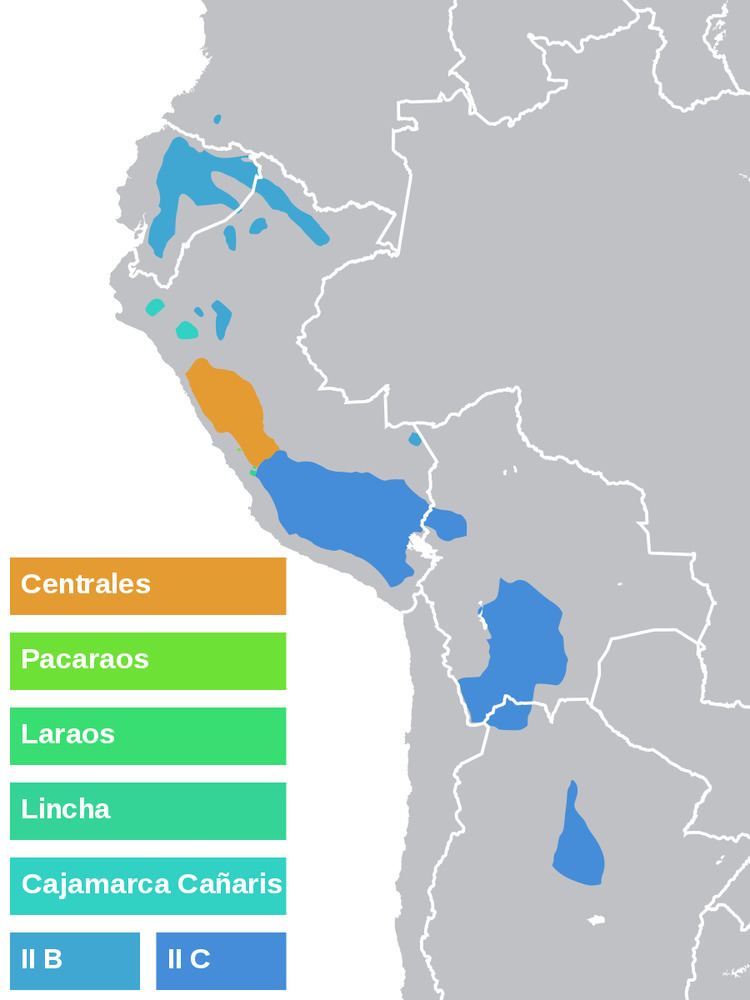Ethnicity Quechua, Qulla | ||
 | ||
Native speakers (6 million cited 1987–2002) Dialects AyacuchoCuscoPuno (Collao)North BolivianSouth Bolivian Santiagueño | ||
Southern Quechua (Spanish: quechua sureño), or simply Quechua, is the most widely spoken of the major regional groupings of mutually intelligible dialects within the Quechua language family, with about 6.9 million speakers. It is also the most widely spoken indigenous language in the entire New World. The term Southern Quechua refers to the Quechuan varieties spoken in regions of the Andes south of a line roughly east-west between the cities of Huancayo and Huancavelica in central Peru. It includes the Quechua varieties spoken in the regions of Ayacucho, Cusco and Puno in Peru, in much of Bolivia and parts of north-west Argentina. The most widely spoken varieties are South Bolivian, Cusco, Ayacucho, and Puno (Collao).
Contents
In the traditional classification of the Quechua language family by Alfredo Torero, Southern Quechua is equivalent to Torero's 'Quechua IIc' (or just 'QIIc'). It thus stands in contrast to its many sister varieties within the wider Quechuan family that are spoken in areas north of the Huancayo-Huancavelica line: Central Quechua (Torero's QI) spoken from Huancayo northwards to the Ancash Region; North Peruvian Quechua around Cajamarca and Incahuasi (Torero's IIa); and Kichwa (part of Torero's Quechua IIb).
Dialects
Dialects are Ayacucho Quechua, Cusco Quechua, Puno Quechua (Collao Quechua), North Bolivian Quechua (Apolo Quechua), and South Bolivian Quechua. Santiagueño Quechua in Argentina is divergent, and appears to derive from a mix of dialects, including South Bolivian.
The most salient distinction between Ayacucho Quechua and the others is that it lacks the aspirated (tʃʰ, pʰ, tʰ, kʰ, qʰ) and ejective (tʃʼ, pʼ, tʼ, kʼ, qʼ) series of stop consonants. The other varieties of Bolivia and Southern Peru taken together have been called Cusco–Collao Quechua (or "Qusqu–Qullaw"); however, they are not monolithic. For instance, Bolivian Quechua is morphologically distinct from Cusco and Ayacucho Quechua, while North Bolivian is phonologically quite conservative compared to both South Bolivian and Cusco so there is no bifurcation between Ayacucho and Cusco–Collao.
Santiagueño also lacks the aspirated and ejective series, but it was a distinct development in Argentina. It also maintains remnants of the Quechua s–š distinction, which has otherwise been lost from Southern Quechua, which suggests other varieties of Quechua in its background.
Standard Quechua
The Peruvian linguist Rodolfo Cerrón Palomino has devised a standard orthography intended to be viable for all the different regional forms of Quechua that fall under the umbrella term Southern Quechua. It is a compromise of conservative features in the pronunciations of the various regions that speak forms of Southern Quechua. It has been accepted by many institutions in Peru and Bolivia and is also used on Wikipedia Quechua pages, and by Microsoft in its translations of software into Quechua.
Here are some examples of regional spellings different from the standard orthography:
In Bolivia, the same standard is used except for "j", which is used instead of "h" for the sound [h] (like in Spanish).
The following letters are used for the inherited Quechua vocabulary and for loanwords from Aymara:
a, ch, chh, ch', h, i, k, kh, k', l, ll, m, n, ñ, p, ph, p', q, qh, q', r, s, t, th, t', u, w, y.
Instead of "sh" (appearing in the northern and central Quechua varieties), "s" is used.
Instead of "ĉ" (appearing in the Quechua varieties of Junín, Cajamarca, and Lambayeque), "ch" is used.
The following letters are used in loanwords from Spanish and other languages (not from Aymara):
b, d, e, f, g, o.
The letters e and o are not used for native Quechua words because the corresponding sounds are simply allophones of i and u that appear predictably next to q, qh, and q'. This rule applies to the official Quechua orthography for all varieties. Thus, the spellings ⟨qu⟩ and ⟨qi⟩ are pronounced [qo] and [qe].
The letters appear, however, in proper names or words adopted directly from Spanish:
c, v, x, z; j (in Peru; in Bolivia, it is used instead of h).
